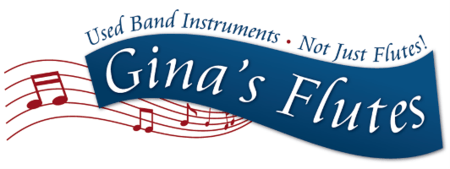This article is a guide for buying a used flute. A companion video is linked at the bottom of the article. Here are some important tips about buying a used student flute:
Features of a student flute:
- Pitch: Most student flutes are in the key of C and will have 2 keys on the foot joint. Intermediate and professional flutes may have a B-foot, which will have 3 keys on the foot joint.
- Key Style: Most student flutes are closed-hole (also called plateau)-- all the keys are solid. Closed holes allows the student to focus on the other aspects of learning to play the flute. Most intermediate and professional models are open-hole (also called French style). Open holes give nicer tone and allow for note-bending.
Mpst student flutes have offset-G keys, which allow easier positioning for the small hand. - Material: Nickel-plated flutes look like chrome. The plating doesn't wear as well as silver, and they usually gave a harsher tone. Silver-plated body and keys looks like Grandma's silver. Silver plating lasts and gives a nice tone. Solid silver components are usually found in intermediate and professional flutes. Solid silver produces sweetness in tone and, of course, adds to the cost of the flute.
-
Brands: Brand is important. Cheapest is not the best route. There are many low-quality brands that can be purchased online for less than $100. They don't have good quality, aren't durable, and have inferior tone quality. The player won't have a good playing experience and may get discouraged. There are many good brands, including Yamaha, Gemeinhardt, Pearl, Armstrong, and Emerson. These are examples of brands that are tried and true for durability and quality.
If you call Texas home, band programs often require Yamaha open-hole flutes for their beginning students. -
Condition: First, look at the tubing. It should be free of severe dents, deep scratches, pitting, and corrosion. Then, look at the pads - they should be clean, solid, and should completely seal when depressed. Many used flutes have worn pads. If pads need replacing, a complete pad replacement can easily cost over $200. Put the flute together. Each section should go on easily and should not be loose or wobble. Finish should be consistent and shiny.
Should I rent or buy? Renting a flute costs around $25/month. If you rent for a year, that cost is $300, and you still don't own the flute. Buying a used flute that has been checked and serviced, like the ones at Gina's Flutes and other reputable dealers, is a smart and economical choice for owning your flute. Gina's Flute's checks each flute for sound playing condition. Our satisfaction guarantee allows you to buy the flute at no risk.
Gina's Flutes extensive used flute collection, from student to professional, can be found on the used flutes for sale page.
So choose your used student flute carefully, and then enjoy making your flute sing!
